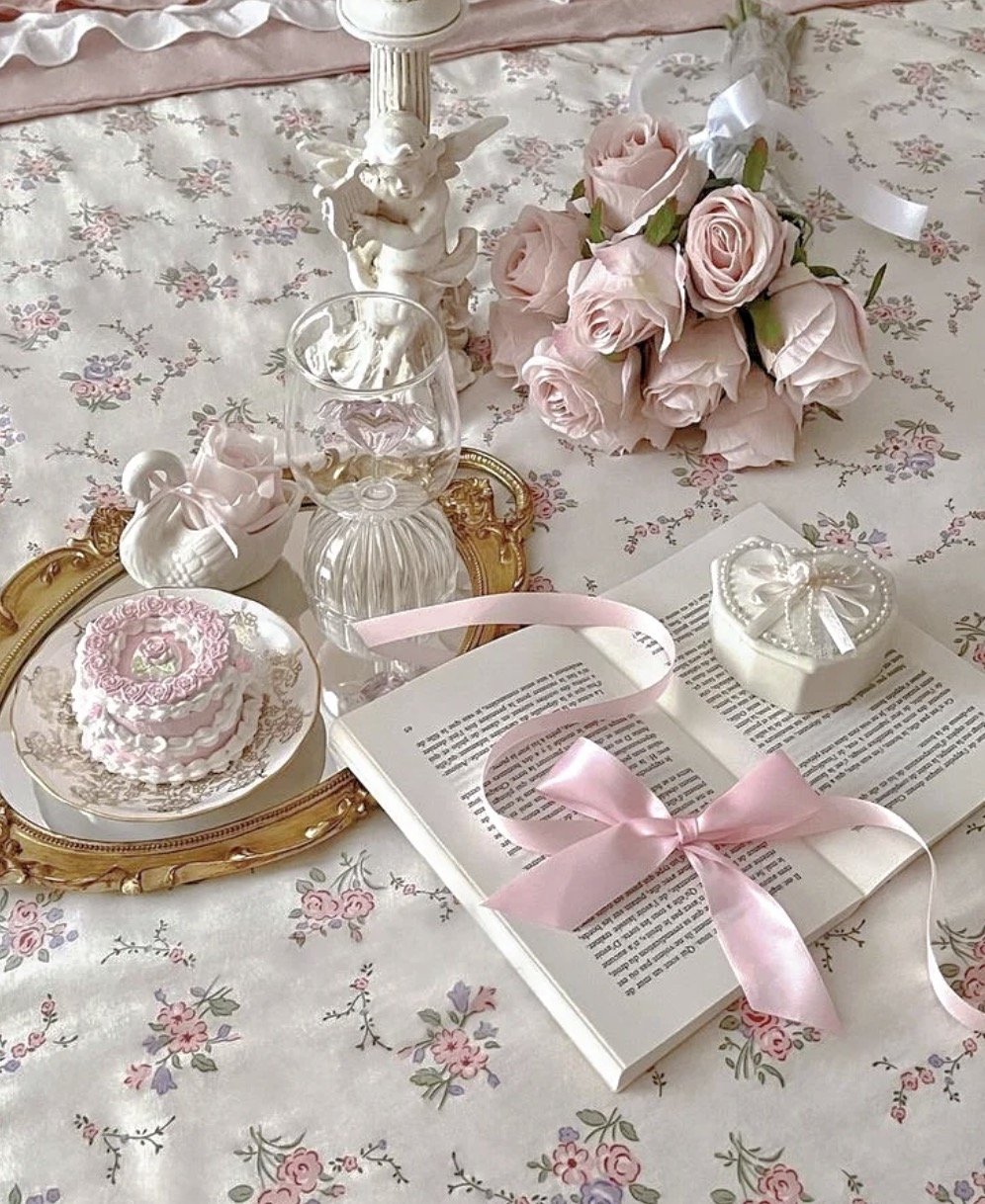
Teaching Philosophy Statement
My teaching philosophy is visually coordinated with the design of my drawings, which are also clipped on some of the pages, such as the lotus flower that represents the origin of my name. For the final conclusion I used zines paired with illustrations to present the content, likening the students' imaginations to the flying pigeons, pearls hidden under the sea, stars covered by castles, and butterfly 's colorful wings, to summarize my theme of flowers and animals and my emphasis on artistic creativity.
Teaching philosophy
Introduction: Art as a Pathway to Meaning-Making
Art, in its many forms, offers students a vital pathway to explore, document, and reinterpret the world around them. My teaching philosophy centers on the belief that creativity, imagination, and personal reflection are essential to deep and meaningful learning. Integrating artistic practices into literacy education fosters not only technical skill development but also independent thinking, emotional expression, and interdisciplinary understanding. Inspired by research and personal explorations with sketchbooks, collages, painting, poetry, and visual storytelling, I believe that learning should be an embodied, reflective, and joyous journey—one where students become active constructors of knowledge rather than passive recipients.
- The Power of Imagination in Learning
Imagination is the heartbeat of creativity and self-expression. As Eisner (2002) reminds us, it is often the surprising moments of imagination, rather than strict prediction or structure, that lead to transformative learning. In my teaching, I see imagination not merely as a playful addition, but as an essential way for students to connect deeply with literature, to construct new meanings, and to envision possibilities beyond what is written on the page. Just as a sketchbook serves as a "visual diary" and a space for independent exploration, imaginative exercises empower students to be authors and artists of their own intellectual journeys.
- Motivation and Engagement: Fueling the Inner Fire
True learning begins with engagement. As Dr. B (2025) emphasized, nurturing passion and curiosity matters more than raw technical ability. When students see themselves as creators rather than passive receivers, they are intrinsically motivated to explore, question, and grow. Like Jessica’s tree metaphor—where nurtured branches flourish and neglected ones wither—literacy blooms when students’ voices are heard and valued (Davis, 2008). Through creative, personalized projects like sketchbook collages or poetry-painting hybrids, I strive to build a classroom where motivation stems from authentic self-expression and the joyful discovery of ideas.
- Embracing Diverse Art Forms
Students express themselves in many ways beyond traditional drawing. Inspired by Goldberg (2012), incorporating embroidery, collage, oil painting, zines, dance, and music enriches their literacy experiences by offering multiple modes of communication. This multimodal approach supports Gardner’s theory of multiple intelligences (Gardner, 1983). In my classroom, a student might use embroidery to map a poem’s emotional arc, create a zine to retell a folk tale, or choreograph a dance to embody a narrative theme. Each medium taps into different skills and intelligences, honoring the unique talents of every learner.
- Bridging Art with Science and Mathematics
Literacy learning does not exist in isolation; it flourishes when connected across disciplines. Inspired by Barone and Eisner (2012) and Taggart et al. (2017), I incorporate mathematical concepts like symmetry and transformation into visual arts projects (such as tessellated ginkgo leaf patterns), and scientific inquiry into watercolor-salt experiments that mimic ocean gradients. These interdisciplinary activities allow students to experience the interconnectedness of knowledge, breaking down traditional silos and fostering holistic, creative thinkers.
- Learning from the Past: The Role of Museums and Historical Artworks
Art education should cultivate a dialogue between past and present. Museum visits and the study of historical artworks provide students with rich cultural and aesthetic foundations. Following the ideas of Eisner (2002) and Greene (1995), I believe that engaging with the work of previous generations inspires students to situate their own creations within a broader historical and cultural narrative. It teaches them to honor tradition while forging new paths of expression.
- The Importance of Reflection: Seeing the Hidden Garden
As Pratt (1991) and Dr. B argue, reflection is key to meaningful teaching. In my practice, I invite both myself and my students to uncover the "hidden gardens" of our minds—the insights, questions, and dreams that might otherwise remain invisible. Through visual journaling, reflective painting, and personal storytelling, students learn that self-awareness and literary analysis are not separate tasks, but intertwined parts of becoming thoughtful, literate individuals.
- Using Poetry and Visual Language to Deepen Literacy
Poetry offers students an opportunity to engage with language at its most distilled and powerful. As Leavy (2009) and Goldberg (2012) suggest, poetic inquiry invites emotional and intellectual investment. By creating art from words—paintings built from scattered letters and carefully chosen verses—students learn to see literacy as both an analytical and an emotional process. Selecting a single word becomes as meaningful as selecting a brushstroke, cultivating an appreciation for nuance, tone, and rhythm.
- Expanding Social Studies Through Arts Integration
Music, theater, and film are transformative tools for teaching history and social issues. As Leavy (2015) and Scott (2015) propose, these mediums foster historical empathy, critical reflection, and cultural awareness. In my classroom, students might embody historical figures through drama, analyze songs from different movements, or storyboard films about cultural identities. These arts-based approaches make the study of human experiences dynamic, emotional, and personal.
- Data as Beauty: Embodying Critical Literacies
Drawing inspiration from Dear Data (Lupi & Posavec, 2016), I encourage students to view everyday experiences and sensory observations as forms of narrative data. Literacy learning can involve creating visual postcards of "hidden beauty," mapping emotional journeys, or collecting sensory details from their surroundings. This method teaches critical data literacy: understanding that "facts" are not just numbers, but lived, felt realities embedded with meaning and story.
- Collaboration with Teaching Artists and Communities
Finally, I believe that learning flourishes when classrooms open their doors to broader artistic communities. Collaborations with teaching artists and partnerships with museums, local theaters, and cultural institutions enrich the curriculum, offering students diverse voices and perspectives. As Goldberg (2012) and Leavy (2015) note, such collaborations bridge school-based learning with real-world creativity, helping students see themselves not just as learners, but as participants in a larger cultural conversation.
- Community Collaboration and Cultural Connection
Bringing in teaching artists, community storytellers, and cultural practitioners connects students’ classroom learning to the wider world. Collaboration enriches education by embedding authentic, lived experiences into the curriculum, highlighting diverse voices and traditions. As Goldberg suggests, teaching artists act as bridges between educational institutions and the broader artistic community, making learning culturally responsive, meaningful, and empowering.
Conclusion: A Vision for Literacy Learning
By weaving art into the fabric of literacy education, I envision a classroom where students are explorers, storytellers, scientists, and artists. Literacy is not confined to reading and writing but becomes a multidimensional practice involving seeing, feeling, creating, and questioning. Through imagination, interdisciplinary exploration, cultural engagement, and self-reflection, students build not only knowledge but also resilient, empathetic, and creative identities ready to navigate the complex world ahead.

Reference
Barone, T., & Eisner, E. W. (2012). Arts based research. http://ci.nii.ac.jp/ncid/BB15910305
Davis, J. H. (2008). Why our schools need the arts. Choice Reviews Online, 46(05), 46–2802. https://doi.org/10.5860/choice.46-2802
Eisner, E. W. (2002). The arts and the creation of mind. Choice Reviews Online, 40(08), 40–4405. https://doi.org/10.5860/choice.40-4405
Klitgaard, R., & Gardner, H. (1983). Frames of Mind: The Theory of Multiple Intelligences. Journal of Policy Analysis and Management, 3(4), 627. https://doi.org/10.2307/3324560
Goldberg, M. (2012). Arts Integration: Teaching Subject Matter through the Arts in Multicultural Settings. https://openlibrary.org/books/OL28469126M/Arts_Integration
Greene, M. (1995). Releasing the imagination: essays on education, the arts, and social change. Choice Reviews Online, 33(08), 33–4642. https://doi.org/10.5860/choice.33-4642
Leavy, P. (2009). Method Meets Art: Arts-Based Research practice. https://ci.nii.ac.jp/ncid/BA86892920
Kienle, N. (2019). Dear Data: Feminist Information Design’s Resistance to Self-Quantification. Feminist Studies, 45(1), 129. https://doi.org/10.15767/feministstudies.45.1.0129
Pratt, M. L. (2016). Arts of the Contact Zone. Education. http://l-adam-mekler.com/pratt_contact_zone.pdf







